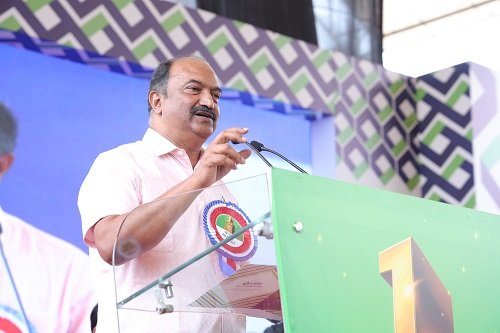At the first interactive session on Delhi’s heritage, the Municipal Corporation of Delhi (MCD), as part of its inaugural heritage walks and talks initiative held at Town Hall, Chandni Chowk, experts delved into the mystery surrounding the grave of Dara Shikoh, the eldest son of Mughal Emperor Shah Jahan and a great Sufi thinker, who was brutally executed. A theory about Dara Shikoh’s final resting place was presented by Sanjeev Kumar Singh, the chief executive engineer of the MCD’s Heritage Cell.
Two events will be held every month till March as part of the MCD’s heritage initiative. They include immersive heritage walks across Delhi’s historical landmarks such as Feroz Shah Kotla, Humayun’s Tomb, and Lal Kot, and interactive sessions highlighting the city’s cultural richness: from Urdu poetry to the classical music of the Delhi Gharana and the dance form of Kathak.
Delhi’s winter brings droves of tourists, and heritage walks—organised by the government-run Delhi Tourism Corporation and private companies such as Enroute Indian History—that bring the capital’s history to life, have grown in popularity. In 2024 alone, Enroute India History conducted 143 walks which saw the participation of almost 2,500 people.
However, walks organised by the private sector often come at a steep price, ranging from Rs.600 to as much as Rs.3,500 per person, undermining accessibility and the educational and cultural potential of these walks. It was in response to this trend that the MCD’s Heritage Cell launched its own Heritage Walks and Talks initiative. Singh said these walks are not profit-driven but aimed at making Delhi’s heritage available to everyone to engage with.
Also Read | India’s heritage influencers: Unearthing stories, archiving the past
“We want to share Delhi’s heritage with its people, whether cultural or related to monuments. People should not only see or read history, but they should also feel it,” he said. Singh emphasised the importance of inclusivity, whether in terms of socio-economic background, gender, or age.
But the privatisation of heritage preservation activities is concerning, although the MCD and public bodies such as the Archaeological Survey of India (ASI), Delhi Development Authority (DDA), and New Delhi Municipal Council (NDMC) are in charge of the upkeep and preservation of Delhi’s heritage sites.
For instance, the Central Government’s “Adopt a Heritage” initiative, introduced in 2018, allows private and public sector companies to develop, maintain, and provide amenities to India’s centrally protected monuments. While the scheme has seen 66 monuments adopted as of August 2024, it has faced strong criticism from historians and conservationists for what they see as a commodification of cultural assets.
The Dalmia Group, after adopting the Red Fort, introduced a light show with ticket prices as high as Rs.1,500 per person. Similarly, at Humayun’s Tomb, plans for a restaurant, sound and light shows, private dining and special events in the gardens have been proposed by the Aga Khan Trust for Culture.

Sanjeev Kumar Singh, chief executive engineer of the MCD’s heritage cell, presents his research on Dara Shikoh’s final resting place at the Town Hall in Chandni Chowk on December 21, 2024.
| Photo Credit:
Vitasta Kaul
Anushka Jain, founder of Enroute Indian History, which tailors its walks to include gendered history, often focussing on female figures and lesser-known stories of Delhi’s past, critiqued the privatisation of Delhi’s heritage: it is the government’s responsibility, not private entities’, to safeguard the nation’s cultural legacy, she believes. While acknowledging that privatisation may lead to more efficient and timely maintenance, she pointed out significant downsides. “One of the foremost concerns is ticket prices. Just three years ago, residents of Chandni Chowk could easily visit the Red Fort for a nominal fee. Today, after sunset, the entry fee has skyrocketed to Rs.600 per person, making it unaffordable for many locals, especially those living in Old Delhi.”
The second issue, says Jain, is accessibility. Privatisation has rendered many monuments either entirely or partially inaccessible. “Heritage walks can no longer be conducted in these spaces, nor can people visit them for a modest Rs.20 as they once could. Large, historic sites are being closed off or restricted.”
History and heritage are collective assets that belong to everyone. “For a private company to tell people they can’t access their own heritage is absurd. Privatisation has alienated people from these spaces. Attendance at such monuments has declined because the exorbitant fees deter visitors.” According to media reports citing ASI data, the Red Fort attracted 7,58,118 tourists, and Humayun’s Tomb 1,85,254 from April to July 2024. In contrast, during the same months in 2023, the Red Fort had 7,70,846 visitors and Humayun’s Tomb 2,06,769.
‘Badass begums’
From her experience of her own company, Jain has gathered interesting insights into what people want: they are hungry to learn about historical stories. “They love legends and bazaar gossip; people are not generally interested in architecture. Our tawaif or badass begum walks are so popular.” Interestingly, more women than men attend our walks, the ratio being nine to one, she told Frontline.

The Sunder Nursery allows no games and is under constant surveillance.
| Photo Credit:
Vitasta Kaul
In July 2024, India’s first sunken museum opened at the Sunder Nursery complex in Delhi. Located underground, it celebrates the life of the second Mughal emperor, Humayun, through paintings, scrolls, and artefacts. The design of the museum reflects a seamless blend of architectural innovation. But there is a catch: Sunder Nursery, unlike traditional open public spaces such as the Lodi Garden, is a gated, curated space with paid entry, restricting it to those who can afford the entry fee. The “public” park allows no games and is under constant surveillance; the cafes and shops built here only add to the commercial experience.
The construction of this museum began in 2015 by the Aga Khan Trust for Culture on the ASI’s behalf. The Trust, along with the ASI and the MCD, undertook the urban conservation and development project in 2007 that spanned 300 acres (121 hectares) of the Humayun’s Tomb complex. This included extensive work on the adjacent Sunder Nursery, which is now a 90-acre heritage park, and the Nizamuddin Basti, a lower-income settlement surrounding the dargah of Sufi saint Hazrat Nizamuddin Auliya.
Frontline reached out to the Aga Khan Trust for Culture to inquire about efforts to make Sunder Nursery a more inclusive public space but received no response.
Also Read | Vivid portrayal of life in Mughal-era Delhi
Meanwhile, Delhi’s Town Hall in Chandni Chowk, the 162-year-old legacy building, is set to undergo restoration this year. Singh said, “So far, the Aga Khan group has proposed its plan. We will go through their blueprints. If the plan is accepted, then a tender will be floated. All of this reconstruction will happen under the supervision of Aga Khan Trust for Culture and MCD’s Heritage Cell.”
Stones that bear diamonds
The challenge is now about balancing preservation and inclusivity, ensuring that Delhi’s rich heritage is open to all, not just a privileged few. Says Singh: “We don’t realise the importance of our culture and heritage. Jisko hum pathar samajh rahe hai, voh toh hakeekat me heera hai [what we think is stone, in reality, is a diamond]. The day we understand this, conservation will automatically happen.”
At a time when history is being actively and erroneously rewritten, initiatives such as the MCD’s free-of-cost heritage walks acquire huge importance, helping people dismantle misinformation and also go past the so-called academic elitism surrounding history. Delhi’s cultural legacy needs to be reclaimed from exploitative commercialisation.


